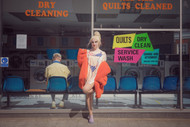Jun 16th 2021

What drew you to photography?
What made me fall in love with photography was the simple magic of capturing a moment that will never exist again. Although everyone can take photographs and you can do it everywhere, it is a craft which can be developed and honed throughout a lifetime.

Where do you look for inspiration?
These days I mainly find inspiration in people and how they express themselves. But I find inspiration everywhere. From nature to people, it’s all about telling a story with an image. Each person and place has a story to be told.

What type of cameras and lenses do you use?
My biggest love is Polaroid and medium format photography. Polaroid for the magic and instant results. It creates an image never to be created again. It’s the opposite of what digital photography is today, I find something magical and romantic in this.
For more commercial work I use my trustee Canon 5D Mark VI with a vintage prime 35mm lens or a ‘nifty 50’ lens. For personal work and projects, I tend to shoot on film and I use my age-old 35mm Pentax because it’s been with me for a long time and I love the look and feel of the image.

Are there any projects you are especially proud of?
A book and an exhibition called Brighton Transformed is one of my first major projects I’m proud of, because it documents the lives of 20+ trans people. I worked with each contributor to produce all the images for the exhibition and book. I documented each person in their favourite most comfortable place and also took their portrait in black and white against a black background which contrasted the colour images.
Another project documented the 5th year of Trans Pride in Brighton & Hove. This involved photographing and interviewing a number of Trans people who were attending this heartfelt event. I took each person's portrait and also asked them about their journey. Some people went every year, while others were visiting for the first time.
I was interested in what an event like this meant for trans people, where they were the majority and could feel such a sense of family, celebration and connectivity. Some curated images were published in various magazines including Vice and Broadly. One of the images from this project was selected to represent Brighton and Hove in a rainbow cities exhibition around the world.

How did you get into photography?
Photography was always something that fascinated me. For many years I ran a framing and ‘art on walls’ service, so I was able to expand my repertoire with different types of photography and learn through projects and practical experience.
As someone who is fiercely independent, I taught myself through just being out and about with my camera. For the past decade, I’ve pretty much taken my camera everywhere I go, from the beach to the clubs.

What subject draws you to take a photo of it?
The world we live in is fascinating from our environment to the people and creatures in it, so I love working with natural light to set the scene, like a movie still.
The subject matter that I’m interested in documenting is people’s identities especially queer people mainly female or non - binary identified humans and lgbtq families.
Can you share some tips on how you shoot your images?
My tips are to trust your gut and your vision. Be ready to capture the unexpected and also patience to capture the moment that could happen straight away or take time.
The better the connection with your subject the better the image or portrait. With portraits, it helps to develop a rapport with your subject to help them relax as much as possible. Connection is what creates a great image.
Photography for me means to transform emotion into art; to use my emotion and instincts to navigate my creativity. My instincts help me to capture what I capture.

What’s the secret! Are there any specific types of equipment for taking these kinds of photos?
As most people are aware, you can take an amazing photo on a phone these days, so equipment matters less. The equipment really is just the vessel and it’s down to you to create the image.
You grow by doing things, so develop your style through projects and collaborations. Ultimately, it’s about using your instincts and trying to capture the things you love or are interested in.
- Take your camera everywhere as you never know who or what you could encounter.
- Learn to work with lighting and practice getting your framing right so there’s less trickery required in the post edit.
- The more you practice the better you’ll get. Persistence pays off.

What has been your biggest challenge in pursing a career in photography?
Photography in general is a fairly competitive industry and making a living from it is what I have found the most challenging in the past. I have come to accept and love this about photography as a profession and art practice. Each of us is unique and has something different to offer. There is room for everyone. You are the filter. It’s not just a picture of X, it’s a picture of X taken by YOU.
What advice would you give to someone starting a career in photography?
Follow your heart and keep pursuing your dream no matter what.




